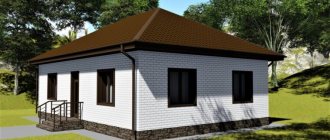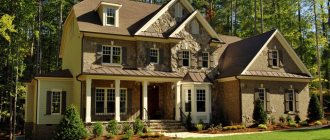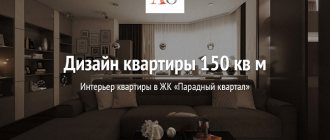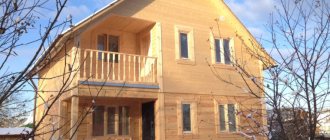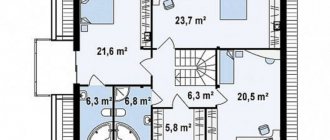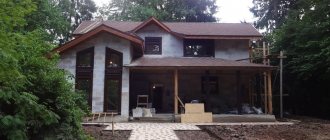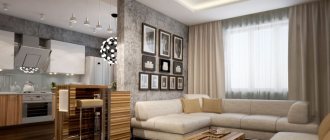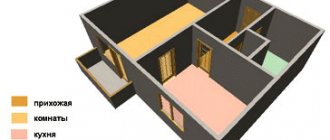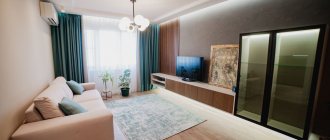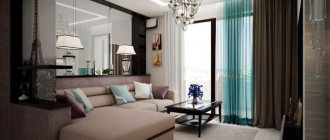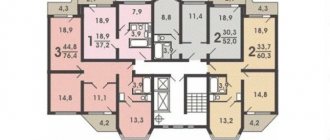When a developer chooses a country house project or looks at the price of a finished house, he wants to solve two main problems:
- Build a beautiful and cozy home for your family.
- Fit into the planned construction budget.
At this stage, the developer faces many pitfalls. For example, gigantomania or a descent into “hello from the 90s!” architecture. FORUMHOUSE will help you avoid them. We will show you 20 beautiful and harmonious country house projects with prices and expert comments.
Colonial style house design
Colonial-style homes may feature classic details such as porticoes with columns or pediments, and mullioned double windows with shutters. Inside a colonial home, you will typically find a central staircase hall, a living room opposite a dining room, and a kitchen at the back of the house.
If you're looking for a family-friendly design that makes entertaining special, a Colonial style house plan may be just what you need!
Features of drawing up a house project - drawings as the basis for planning
Drawings help to roughly visualize the final appearance of the building: outside and inside. There is no point in rushing to create the final sketch. It is better to spend a lot of time and anticipate more nuances. Drawings can be adjusted time after time to new ideas, taking into account further life activity on the site and inside the building. It is even possible to provide for the addition of floors.
In the diagrams, the first thing to indicate is their number, as well as the type of upper tier. The roof can be flat and sloping, and there may be an attic underneath it. Areas are planned inside: work, for cooking, for relaxation, etc. Outside - utility rooms, outbuildings, gardens, common areas. Territories with similar functional loads are located close to each other. All of the above aspects form the basis for the design of ready-made plans. Each finished project is a variant with a full set of necessary devices and functions.
European style: castle house plans
If you are a Game of Thrones fan, then you might like these castle house plans. Their sleek exteriors conceal modern open floor plans (with ample amenities), large kitchen islands, home offices, and more.
A den on the main level can be used as a convenient home office. Notice the large master bedroom that opens out to a private patio - it's a great home layout.
Video description
To see what a house should be like, watch the video:
Balcony in a private house
Some owners of private houses with balconies hardly use these extensions. According to people, it is easier to go out into the yard or onto the terrace. That is why the need for a balcony must be thought out in advance.
If you want to make one, then you should not build a small balcony similar to those that are equipped in apartment buildings. A large balcony is turned into a work of art using forged or other equally beautiful railings.
There should be enough space on the balcony for a comfortable rest - so that you can put several sun loungers or a rocking chair, a table with chairs for tea drinking.
Large balcony in a private house, equipped with everything necessary for a comfortable stay Source pinterest.com
The balcony fence must be at least one meter high to ensure safety. If there is no canopy, snow may drift onto the balcony in winter. If the floor does not have a slope, then after rain water will stagnate there.
Design of a two-story house with an open plan
You'll love the super open floor plan of this castle home. The den can be used as a home office, and the covered porch is the perfect place to relax after a long day. Note the walk-in closet in the master suite. The second floor features a loft, bonus room and two additional bedrooms (each with their own bathroom).
What to consider when drawing up a house plan
To draw up a plan, you need to decide on the number of storeys of the building, roof option, exterior, including the number of window openings, balconies and loggias. The possibility of arranging a terrace and attic should be provided. All these elements need to be displayed in longitudinal and cross sections, along with the design qualities and the required materials. The features of the site for the house are taken into account, including location, orientation to the cardinal points, relief, and soil features. The optimal internal layout, primarily the location of the premises, depends on them. The number and configuration of rooms is selected taking into account the number of residents and the age of each of them.
The main priority when drawing up a diagram is functional usefulness. Facilities should also be provided to accommodate construction workers and other workers. It is advisable to leave space in reserve on the plan: someday it may be “filled up” with an additional garage or guest house.
Some functional elements that are better to be provided in advance:
- workshop;
- cabinet;
- greenhouse;
- winter Garden;
- sauna;
- pool;
- Gym.
Large rooms need additional heating!
Small house plans we love
Affordable and easy to build, small home plans waste no space while providing comfortable living spaces. A modern farmhouse adds stylish curb appeal with clapboard and clapboard borders and a cozy front porch.
A two-car garage offers additional storage space if needed. Modest square footage and small layout make it affordable to build.
Each bedroom has a walk-in closet! The open floor plan keeps everything feeling modern, with an island kitchen overlooking the great room. The master bedroom has a walk-in closet, double vanities and a spacious shower. Don't miss the cool terrace on the second level.
Related documentation for the project and construction drawings
The project contains information about the stages of construction and the implementation of certain types of work. The master plan and detailed drawings are supplemented with explanatory tables and various annexes. In addition to individual plans that take into account personal preferences and special needs, mandatory documents with key data will be needed. These include documentation with a list of finishing and building materials, information about their type, documents describing engineering solutions, information about finances and technical aspects.
You will need data on height, area, mass and volume in cubic meters (cubic capacity). A description of the functionality of the building must be drawn up. This also applies to documentation with architectural and structural assessment. Based on the project, it is customary to organize a process that includes a certain sequence of construction work and associated financial costs.
The architectural passport contains:
- Copy of the designer's license;
- Plan and schematic cross-sectional images of the roof;
- Floor plans;
- Coloring of external walls;
- Explanatory note.
Huge garage-type residential building
The garage residential building occupies a picturesque site. Walls of windows bring light inside, illuminating the open floor plan. The kitchen opens directly into the living space for a seamless transition.
The bedroom is located at the rear of the layout for added privacy and has a large closet. Enjoy outdoor living on your cool balcony.
Computer programs for house design
You can design a house using applications:
- Google SketchUp;
- VisiCon;
- FloorPlan 3D;
- CyberMotion 3D-Designer 13.0;
- Home Plan Pro;
- AutoCad;
- House-3D;
- Envisioneer Express.
These tools are designed for modeling three-dimensional architecture, including one-story and two-story houses, dachas, and cottages. As an additional function, the programs allow you to virtually arrange pieces of furniture. Special plugins and extensions of these applications visualize objects. Thanks to this option, you can see how buildings look from above, in section, at an angle. In addition, modeling applications allow you to work with layers.
Models can be edited at any time, as well as rotated around their axis or enlarged to view the smallest details. To store different projects, libraries are provided in which you can quickly and easily view objects. Modern programs also allow you to create dynamic elements. Paid and free applications and online resources are available on the Internet to test design features under the most realistic parameters.
House with an attic
The layout of a house with an attic is the most popular choice of most investors who decide to build a house in Russia.
These house plans are popular for economic reasons - they are best suited for implementation, do not require as large a site as a bungalow, and yet have a human scale than period houses - thanks to the eaves that go down under the roof.
Houses with lofts offer less protection to the garden, which can make a big difference in a small area. And finally, most provisions in municipal plans provide for mansions, houses with an attic, with a relatively sharp roof angle.
In our offer you will find both houses with a gable roof, and with a hip roof, with attic windows. Attic houses with traditional architecture and modern layout. We invite you to familiarize yourself with our offer.
Cottages from
The popularity of cottages built on country plots of land in Moscow and the Moscow region is constantly growing. Our company builds turnkey cottages using frame technology, houses made of logs, timber, bricks, aerated concrete blocks and other high-quality building materials produced in Russia, Finland, Denmark and the Czech Republic at a competitive cost.
Among the advantages of buildings erected by our specialists:
- good thermal insulation;
- environmental friendliness;
- durability;
- suitability for year-round use;
- spectacular appearance.
Two story house plan
The typical house design in the long history of home building is the popular and current two story house plan. The layout of a two-story home can include a wide range of architectural styles.
Accompanied by a variety of price points to suit the varied tastes, personalities and family requirements of our customers. With the ever-increasing need to separate work and play, the two-storey home offers plenty of space for flexible family living in a warm, welcoming environment specifically designed for single families.
The dramatic and stately heights of ceilings and rooms, formal and/or casual living spaces, extravagant or practical room designs, and the addition of multifunctional and accessory areas in two-story homes are as varied as the people who occupy them.
This creative canvas allows homeowners to virtually customize their space in their dream home; often without sacrificing privacy or space.
Multi-story homes offer levels of living not found in other types of homes, with specific defined space for entertaining, sleeping, and the availability of attached outdoor space for children.
Advantages of our services
You can order the service of building cottages in Moscow and the Moscow region on our website. In the catalog, you can choose the most suitable project and make changes to it if you are not satisfied with the layout or cost, or order an individual design of your country house.
The advantage of our services is the high-quality execution of orders of any complexity in the shortest possible time and attractive prices for turnkey cottage construction services. At all stages, careful control is carried out, which is a guarantee of the high quality of any work performed.
How to make your own home layout?
Planning a house with dimensions is possible on free platforms for creating a house on the Internet. After this, you can take a photo and give it to the developer so that it is clear what is required of him.
It is necessary to understand that an online project cannot serve as a real project. The development is carried out according to a project developed by the architect and approved by the architectural commission. Your online project can be a prototype of the real project, but for this it must be attributed to an architect.
The differences between houses are not only related to the materials used, the materials used, the quality of workmanship, insulation and connections. What is also important is that the area occupied by construction directly affects the functionality of the structure and the opportunities that tenants will have afterward.
The 8 by 10 m house project is very popular. Such structures are compact and cost-effective (due to the small size of the building and decorations will not leave much money) and the overall functionality does not suffer at all. A house with sides of 8 and 10 meters, well located on a very small piece of land, you can get a strictly individual layout.
Architects manage to fit harmoniously into the plans of all the most important places, even adding to an apartment in the attic or basement. Many options for houses of this type may contain verandas and garages.
Country house stylized as a Japanese cottage
There are developers who dream of a house made in Japanese style. Many do not dare to experiment and limit themselves to small architectural forms similar to Japan. For example, they build gazebos with clearly recognizable curved roofs, like a pagoda.
Here is an example of successful stylization in the oriental style. Not ideal of course, but the house looks very harmonious.
And this is a more successful version of Japanese stylization, made according to an individual project.
Photo of the house layout
Category: Layout ideas Overhead costs and planned savings for work include:
I. Administrative and economic expenses 1. Costs for remuneration of administrative and economic personnel: - management staff (managers, specialists and other employees classified as employees); — line personnel: senior work producers (site managers), work producers, construction site foremen. 2. The amount of payment of the unified social tax (contribution) in accordance with the legislation of the Russian Federation, calculated from the cost of remuneration of administrative and economic personnel. 3. Postal and telegraph expenses, payment for communication services, in particular, payment for international and long-distance telephone calls, conversations using radiotelephones, cellular communications, messages transmitted via paging, costs for the maintenance and operation of telephone exchanges, switches, teletypes, control room installations , radio and other types of communications used for management and listed on the organization’s balance sheet, expenses for renting these means of communication or for paying for relevant services provided by other organizations, expenses for fax and satellite communication services, e-mail, as well as information systems (SWIFT , Internet and other similar networks). 4. Costs for the maintenance and operation of computer equipment, which is used for management and is listed on the balance sheet of the organization, as well as the costs of paying for relevant work performed under contracts by computer centers, machine counting stations and bureaus that are not on the balance sheet of the construction organization. 5. Expenses for printing works, for the maintenance and operation of typewriting and other office equipment. 6. Costs for the maintenance and operation of buildings, structures, premises occupied and used by administrative and economic personnel (heating, lighting, energy supply, water supply, sewerage and cleanliness), as well as costs associated with payment for land. 7. Expenses for legal and information services. 8. Expenses for creating a reserve for warranty repairs and warranty service. 9. Expenses associated with official travel of administrative and economic personnel within the location of the organization. 10. Expenses for the maintenance and operation of official passenger vehicles listed on the balance sheet of a construction organization and servicing employees of the management apparatus of this organization, including: - wages (with deductions for the unified social tax) of employees servicing passenger vehicles; — the cost of fuel, lubricants and other materials, wear and tear, repair of automobile tires, and vehicle maintenance; - expenses for maintaining garages (energy supply, water supply, sewerage, etc.), rent for garages and parking lots, depreciation charges (wear and tear) and expenses for all types of repairs (contributions to the repair fund or reserve for repairs) of cars and garage buildings. 11. Expenses for hiring company cars. 12. Expenses for compensation for the use of personal cars for business trips within the limits established by the Government of the Russian Federation. 13. Expenses associated with the payment of relocation costs for administrative and business personnel, including employees servicing official passenger vehicles, and payment of allowances for them in accordance with the current legislation on compensation and guarantees for transfer, rehiring and sending to work in other areas. 14. Expenses for business trips related to the production activities of administrative and economic personnel, including employees servicing official passenger vehicles, based on the standards established by the legislation of the Russian Federation, including: - travel of the employee to the place of business trip and back to the place of permanent work; — daily allowance and (or) field allowance within the limits of standards approved by the Government of the Russian Federation; — registration and issuance of visas, passports, vouchers, invitations and other similar documents; — consular, port, airfield fees, fees for the right of entry, passage, transit of automobile and other transport, for the use of sea canals, other similar structures and other similar payments and fees; - rental of residential premises. 15. Depreciation deductions (rent) for fixed assets intended for servicing the management apparatus. 16. Representation expenses related to the activities of organizations: expenses for receiving and servicing representatives of other organizations (including foreign ones) participating in negotiations in order to establish and (or) maintain mutually beneficial cooperation, as well as participants who arrived at a meeting of the Council (management) or other similar body of the organization. The inclusion of entertainment expenses in the cost of products (works, services) is permitted only if there are primary accounting documents, their documentation and control. Actual expenses should not exceed the limits established by the current procedure. 17. Expenses for ongoing study (research) of the market situation, collection and dissemination of information directly related to the production and sale of work (services). 18. Other administrative and business expenses (payment for services provided by third-party organizations for production management, in cases where the staffing schedule of a construction organization does not provide for certain functional services, etc.). II. Costs of servicing construction workers
1. Costs associated with training and retraining of personnel.
2. Deductions for the unified social tax from the costs of remuneration of workers engaged in construction work, as well as the operation of construction machinery and mechanisms and non-capital work carried out at the expense of overhead costs. 3. Costs for ensuring sanitary, hygienic and living conditions: - arrangement and maintenance of sanitary and household premises (toilet), as well as the cost of hygiene items. 4. Expenses for occupational health and safety: - wear and tear and costs for repairs and washing of freely issued protective clothing and personal protective equipment; - the cost of neutralizing substances, fats, milk, medical nutrition, etc., provided free of charge in cases provided for by the legislation of the Russian Federation; — costs associated with the purchase of first aid kits and medicines, with sanitary, household and medical services for workers; — costs of measures to prevent accidents and diseases in construction, as well as improve working conditions; — costs of contributions for compulsory social insurance against industrial accidents and occupational diseases in accordance with the legislation of the Russian Federation; — costs of training and training workers in safe working methods in the field of labor protection and equipment of safety rooms; — costs of medical examinations; — costs of certification of workplaces; — other expenses provided for by the nomenclature of occupational health and safety measures, except for expenses that are in the nature of capital investments. III.
Expenses for organizing work on construction sites (including from the item of planned savings) 1. Depreciation and repair costs of tools and production equipment used in construction work, accounted for in accordance with the established procedure.
2. Depreciation and expenses associated with the repair, maintenance and dismantling of temporary (non-title) structures, fixtures and devices, which include: - warehouses and sheds at the construction site; — floorings, stepladders, stairs, walkways, walking boards, cast-offs when breaking down a building; — temporary distribution from the main distribution networks of electricity and water within the work area (territories within 25 meters from the perimeters of buildings or the axes of linear structures); - costs associated with the adaptation of buildings under construction and existing on construction sites instead of the construction of the above temporary (not title) buildings and structures. 3. Depreciation charges (rent), expenses for all types of repairs, as well as for the movement of production fixtures and equipment not included in the calculation and taken into account as part of own and leased fixed assets. 4. Expenses for geodetic work carried out during construction work. This article takes into account labor costs (with deductions to the unified social tax from labor costs) of workers engaged in geodetic work, the cost of materials, depreciation, depreciation, costs for all types of repairs (contributions to the repair fund or reserve for repairs) and for the movement of geodetic equipment, tools and instruments, transport and other expenses for geodetic work, including acceptance of the geodetic basis from design and survey organizations. IV.
Planned savings 1. Depreciation of intangible assets. 2. Payments on bank loans (except for loans related to the acquisition of fixed assets, intangible and other non-current assets), as well as on budget loans, except for loans issued for investments and conversion activities. The newly established rates on loans from the Central Bank of the Russian Federation to commercial banks apply to newly concluded and extended agreements, as well as to previously concluded agreements that provide for a change in the interest rate. 3. Advertising expenses.
Material overhead costs include:
1. Labor costs of the supply and logistics department, deductions for the unified social tax from the labor costs of workers in the supply and logistics department. Approximately 3% 2. Transport and forwarding costs; Approximately 15% 3. Costs for organizing the protection of materials at the construction site. Approximately 2% Total approximately 20%.
Winter price increase (additional costs)
arise due to a decrease in worker productivity and the complication of work technology caused by low temperatures (GSN 81-05-02-2007).
Cramped conditions
are characterized by the presence of one of the following factors: 1. Lack of paved roads, or the impossibility of delivering materials on large vehicles. 2. The presence of residential or industrial buildings, as well as preserved green spaces in the immediate vicinity of the work site; 3. Cramped conditions for storing materials or the impossibility of storing them at the construction site for the normal supply of materials to workplaces; 4. During the construction of objects, when the building density of objects exceeds the standard by 20% or more.
Facade design - design stages
STAGE I
After agreeing on the cost (commercial proposal) of the facade design project and the contract, we arrange a meeting at the site to carry out measurement work. On site, the chief architect carefully listens to your wishes for finishing and records them in the terms of reference. We carry out detailed measurements of the facades of the house in order to subsequently create a 3D model, make all the necessary calculations of the amount of finishing materials and decorative elements, and prepare drawings for builders and manufacturers. We photograph facades and their individual fragments from all vantage points. After signing the contract and making an advance payment, we begin the second stage of work.
STAGE II
Based on the measurements, we create a three-dimensional digital model of the building. We know well that each house is unique in its own way, and the first step in working on facade design is to study the features of its architecture in order to determine the strengths and weaknesses and identify the best solution. Initially, we develop 2-3 basic design options for the facades of the house based on wishes for style and finishing materials. You choose the one you like best, express your wishes and comments, and we correct it until final approval. The number of adjustments is unlimited. As soon as the sketch - version of the facade is agreed upon, we proceed to the third and final stage of work.
STAGE III
The facade design project is based on an agreed upon option that best meets your requirements and matches the architecture of the house. At this stage, the facades and 3D views of the house are finally visualized, drawings are prepared, we count the number of finishing materials and decorative elements (we draw up statements, specifications). We layout and arrange everything into a project in A3 format - 2 printed albums (one for you, one for the builders) + an electronic version of the project in PDF. Now open the project for the new facades of your house, feel free to purchase the required amount of materials and begin finishing. For competent implementation of the project, our proven team of builders is needed.
Gallery of our projects
Project of facades of a house 900 sq.m. in neoclassicism. Moscow, Khimki, 2019. Combined finishing is made in a combination of natural materials - limestone tiles of several formats, granite and decorative silicate-silicone plaster
Design project for the facades of a house in a modern style. Moscow, Yuzhnoye Butovo, 2021. Finish: brick-like clinker tiles, composite panels, wood-look fiber cement siding, aluminum panels
Design of the facades of a two-story foam block house in a classic style under construction in the Moscow Region, Odintsovo district. The finishing of the facades was done using artificial brick-like stone Leonardo Stone; in the decoration of columns, plinths and pipes - artificial stone White Hills, decor and frames are polyurethane foam Regent Decor
Project for the reconstruction of the entrance group of a private residential building with facades in a classical style. Architectural and structural solutions for the extension of a carport for two cars. Moscow region, Odintsovo district, Borki village, 2020
Design project for finishing the facades, reconstructing the terrace of a house in KP Pavlovo 2. 2021. The finishing of the facades is made with brick-like clinker tiles King Klinker HF54 Roman theater, the basement part is King Klinker LF05 Black heart
Design of the facades of a one-story house made of aerated concrete blocks in a modern style using decorative plaster and plank. One of the options proposed by the architect. St. Petersburg 2020
Exterior design of a brick house in chalet style. Tver, 2021. The architects used natural rubble stone, brick-like clinker tiles, and a wooden slatted façade on the second floor in the finishing.
Exterior finishing project in a modern style. House 267 sq.m. Ramensky district, KP Berezhok 2, 2021. The decoration of this house used clinker tiles for brick, beveled larch planks, rectangular aluminum slats
Design of the facade of a house 1,500 sq.m. in the Mediterranean style in KP Millennium Park, 2015. Wall decoration - decorative plaster, sandstone tiles of several types and sizes, architectural decorative elements made of polyurethane foam
Project for renovation of facades of a house of 700 sq.m. Wright's style. KP Grafskie Prudy, 2021. In the design, the architects used clinker tiles for NF format bricks of two types, a belt and inserts with a diagonal layout of travertine tiles, and decorative plaster with a bark beetle texture
Facade design, reconstruction of entrance lobbies, fencing project. Moscow, Kurkino, 2021. In the modern decoration of a house of classical architecture, the designer used the following materials: clinker tiles in two formats, aluminum lamellas for planken, polyurethane foam decor
Design in Art Nouveau (modern) style, project for finishing the exterior of a cottage, Vidnoye, 2014. Decorative silicone plaster of several colors and textures, stencil painting, decorative elements made of polyurethane foam, made according to the architect’s original sketches
Project for the solution of facades, reconstruction of a wooden house of 161 sq.m. in Zalesye, 2021. Finishing - wall covering with clapboard with imitation timber, the base is lined with artificial stone in brick format, on the entrance and terrace areas - clinker tiles, wooden decor
Project for the repair of facades with thermal panels (clinker tiles) and plaster. Vidnoe, 2015
Design project of facades with plank and plaster. House 190 sq.m., Andreikovo village, 2019
Facade renovation project, extension to a house of 480 sq.m. in Pestovo, 2016
Classic style. Project for repair and finishing of facades of a private house 306 sq.m. Ramenskoye, 2018
Photo of the implementation of the design of the facades of a frame wooden house 180 sq.m., Raduzhny DP, 2018
An example of solving the facades of a three-story house on a slope. New Seltso, 2019
Classic style. Project of facades with reconstruction of a house of 452 sq.m. in Troitskoye, 2018
Chalet style. Facade repair, reconstruction of a brick house, Novosergievo, 2019
Project for finishing facades in the classic style of a foam block house. KP Bulgakovo Life, 2018
Project for repairing facades and reconstructing a house in the English style. Golikovo, 2016
Design of facades of a brick house in chalet style. Balashikha, 2014
Repair of facades with reconstruction of the entrance group of a residential building in Chiverevo, 2016
Facades of a country cottage 170 sq.m. in chalet style. KP Siesta, 2018
Design project for finishing the exterior of a house in Italian style. Vita Verde, 2016
Design project of the facade and entrance group of a small wooden house. Berezhki, 2017
Design of the facade of a house 1,500 sq.m. in modern style in KP Millennium Park, 2015
- Experience. Since 2007, we have been successfully solving problems related to the design of facades (exterior) of both already built country houses and those just being designed. We develop design and working documentation for new construction and reconstruction, repair of facades. Our team consists of architects, designers, and engineers who love their work.
- Any materials, various architectural styles. We have experience working in different styles, we know the features and necessary conditions for using certain modern facade finishing materials.
- Unlimited number of sketches. An individual facade project is drawn up only after final approval of the option you have chosen. Initially, the architect offers 2-3 initial finishing options, the most liked of which is adjusted until 100% approval.
Variety of materials and construction technologies
Technologies for the construction of individual residential buildings are very diverse, depending on the material and purpose. If you need to build a budget but reliable house in a short time, you should take a closer look at materials such as foam block and gas block. Brick makes it possible to implement the most daring architectural solutions, but construction will be more labor-intensive and will last much longer. But the brick house will turn out to be beautiful, durable and will last for many years without losing its qualities.
Houses made of wood are very beautiful in appearance; a very comfortable microclimate is created inside them, beneficial for health, due to the phytoncides released by natural wood. Houses made of timber are well suited for individual construction. The best option in terms of price, quality and speed of construction is profiled timber. Houses from it are built quickly thanks to a special method of joining using the tongue-and-groove system. The walls of such a house are very airtight and retain heat well. For suburban construction, rounded logs, SIP panels and frame technologies are often used.

